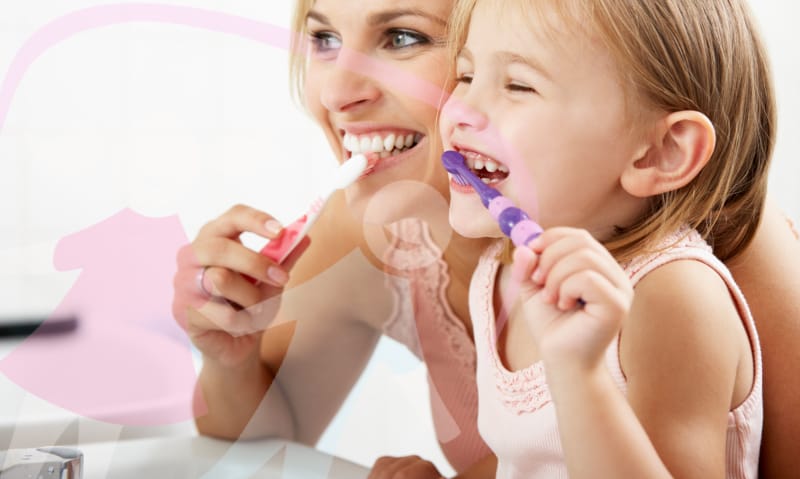7 Tips for Easy, Happy Tooth Brushing for Your Child With a Disability

The best ways to keep dental care fun and stress-free.
Children with sensitive developmental and behavioral needs can often find brushing and flossing to be overstimulating, frustrating, or simply a little boring. At-home dental care is crucial for preventing cavities and pediatric gum disease, so it’s important for parents to find solutions that mesh with their child’s personality and boundaries.
The good news is, there are plenty of toothbrushing tips and tricks from fellow parents who’ve unlocked different ways of making dental care fun and engaging! Here are our favorite toothbrushing tips to make dental care more enjoyable for children with special health needs.
1. Find the right toothbrush for your child.
One of the first things to evaluate is whether you have the right toothbrush for your child. Many store-bought kids’ toothbrushes aren’t sensory-friendly nor easy to handle and manipulate, which can add to stress and frustration.
If your child doesn’t seem to like their toothbrush or finds it difficult to hold, try these options instead:
- Toothbrushes with ultrasoft or silicone bristles
- 3-side manual or powered toothbrushes
- U-shaped powered toothbrushes
- Toothbrushes with large adaptive handles
2. Try an unflavored toothpaste with fluoride.
Toothpaste flavors are often categorized as either minty or fruity. It’s common for either flavor of toothpaste to taste unappealing to children with sensitive palates or may even subconsciously encourage kids to want to swallow rather than spit.
Rather than skipping toothpaste altogether, try using an unflavored toothpaste instead—just be sure it has fluoride for those kiddos over age two. There are several brands available on Amazon, but because the American Dental Association hasn’t yet formally accepted an unflavored toothpaste, we recommend speaking with your child’s dentist for a recommendation.
3. Experiment with flossing alternatives.
Using string floss can be tricky, especially if your child isn’t comfortable opening their mouth wide or having hands and fingers poking around. Flossing is very important for gum health and reducing plaque build-up between checkups and cleanings, so it’s best to find an alternative, rather than skipping it entirely.
Some wonderful alternatives to try with your child include:
4. Choose a comfortable location.
Brushing and flossing don’t have to happen in the bathroom if that isn’t where your child feels comfortable. Switching up the location can make it easier for your child to relax and enjoy their brushing session.
You might try a different bathroom, the kitchen, or grab a large cup or bowl they can spit into and let them sit on the couch or on their bed. Wherever you choose, be sure to supervise to ensure they brush adequately and remain undistracted.
5. Make dental care a twice-daily routine.
Everyone thrives on routine, especially children who need structure to their day. Dental care should become a twice-daily routine that’s practiced morning and night as consistently as possible. Practice this routine yourself to show your child that you prioritize dental care and find it fun to do.
Even if your child is having an off morning or evening and isn’t up for brushing and flossing, see if you can encourage them to at least swish their mouth or lightly brush rather than abandoning the routine entirely.
6. Plan brushing sessions based on mood.
While a consistent routine is usually the way to go, sometimes flexibility is the best answer. If your child is feeling tired or overwhelmed, it’s usually best to wait until the mood passes rather than attempting to have them brush and floss. Waiting to brush until they’re in a happy, calm, and engaged mood adds positivity to the dental care session and reinforces the idea that taking care of their teeth is something that’s fun to do rather than stressful.
7. Use an app or music as a distraction.
You can find an app for almost everything now, and that includes apps designed to guide children through toothbrushing and flossing. These apps are a great way to motivate kids and keep brushing sessions fun. Another option is to play two minutes of their favorite song rather than use a traditional timer.
If your child needs distraction more than motivation, you could try reading a book for two minutes or watching a fun dental care video for kids on YouTube while you brush their teeth. It can also help to have some type of reward after brushing and flossing. Using a tracker, such as a sticker chart, allows them to see their daily progress followed by a reward at the end of the week.
Feeling stuck? Omaha Pediatric Dental Specialists can help.
If you ever feel stuck or unsure of which techniques and tools will work for your child, remember that our team is always eager to help.
Our dentists have extensive training in working with children who have unique health, developmental, and behavioral needs. Their knowledge includes helping parents develop low-stress, fun routines to use at home. Schedule an appointment with your child’s favorite pediatric dentist in Omaha to learn more.